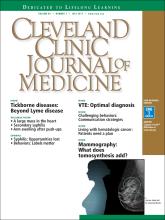Article Figures & Data
Tables
Criteria for deep vein thrombosis Points Active cancer +1 Paralysis, paresis, or recent plaster immobilization +1 Recently bedridden (> 3 days) or major surgery in past 4 weeks +1 Localized tenderness along deep vein system +1 Entire limb swollen +1 Calf swelling by more than 3 cm compared with asymptomatic leg +1 Previously documented deep vein thrombosis +1 Pitting edema, greater in the symptomatic leg +1 Dilated collateral superficial veins (nonvaricose) +1 Alternative diagnosis likely or more possible than deep vein thrombosis -2 Previously documented deep vein thrombosis +1 A score of 2 or more suggests a higher risk of deep vein thrombosis Criteria for pulmonary embolism Points Clinical signs and symptoms of deep vein thrombosis +3 Alternative diagnosis less probable than pulmonary embolism +3 Heart rate > 100 beats per minute +1.5 Immobilization for at least 3 days or major surgery in past 4 weeks +1.5 Previous deep vein thrombosis or pulmonary embolism +1.5 Hemoptysis +1 Malignancy (on treatment, treated in the last 6 months, or palliative) +1 A score of 5 or more suggests a high likelihood of pulmonary embolism Online calculators:
www.mdcalc.com/wells-criteria-for-pulmonary-embolism-pe/
www.mdcalc.com/wells-criteria-for-dvt/Based on information in references 7–14.
Surgery or perioperative period Trauma or fracture Prolonged immobilization Long-distance travel Hormone therapy Pregnancy, postpartum Known malignancy Central venous catheter Inferior vena cava filter Chemotherapy Myeloproliferative neoplasm Paroxysmal nocturnal hemoglobinuria Inflammatory or rheumatologic disease Nephrotic syndrome Known thrombophilia Patient selection
Do not test in patients with provoked venous thromboembolism
Testing may be considered in patients with unprovoked venous thromboembolism who express a desire to be testedPretest counseling
Review the implications of testing for and finding a genetic diagnosis with patient and family membersProper test interpretation
Ensure appropriate timing of initial and needed follow-up testing (eg, not during acute venous thromboembolism, not while on anticoagulation)
Ensure appropriate repeat tests for confirmatory diagnosis of antiphospholipid antibody syndromeProvision of education and advice
Provide patients and family with education (at an appropriate health literacy level and in their preferred language) as to what their results mean and how it will affect them now and in the future (eg, nature of the defect, minimal to no impact on life span, role of testing in family members)Based on information in reference 26.
Thrombophilia Tests Antithrombin III deficiency Antithrombin activity and antigen Factor V Leiden mutation Activated protein C resistance assay
Genetic testingFactor VIII excess Factor VIII activity Protein C deficiency Protein C activity and antigen Protein S deficiency Free protein S antigen
Total protein S antigenProthrombin gene mutation Genetic testing Antiphospholipid antibody syndrome Lupus anticoagulant assay:
Dilute Russell viper venom time
Augmented partial thromboplastin time
Dilute prothrombin time
Kaolin clotting timeCardiolipin antibody Cardiolipin antibody enzyme immunoassay Beta-2 glycoprotein 1 Beta-2 glycoprotein 1 enzyme immunoassay Thrombophilia test Confounding factors Antithrombin level Can be lower in acute thrombosis, neonatal period, pregnancy, liver disease, disseminated intravascular coagulation (DIC), nephrotic syndrome, major surgery, treatment with l-asparaginase, heparin; can be falsely negative with factor Xa inhibitors (for factor Xa-based assays), factor IIa inhibitors (for factor IIa-based assays) Cardiolipin and beta-2 glycoprotein 1 enzyme immunoassays None Factor V Leiden mutation None Factor VIII level Inflammation can raise Lupus anticoagulant False-positive result possible with heparin (if serum level > 1 U/mL), warfarin (if international normalized ratio > 3.5), direct oral anticoagulants Protein C level Can be lower in neonatal period, liver disease, DIC, chemotherapy (cyclophosphamide, methotrexate, and 5-fluorouracil combination), inflammation, acute thrombosis, treatment with warfarin or l-asparaginase; can be falsely negative with direct oral anticoagulants (clot-based assays) Protein S level Neonatal period, pregnancy (free protein S antigen levels and protein S activity levels fall during pregnancy, but total protein S antigen levels remain stable), liver disease, DIC, acute thrombosis, treatment with warfarin, l-asparaginase, or estrogens Prothrombin gene mutation None Based on information in references 34, 36–40.






